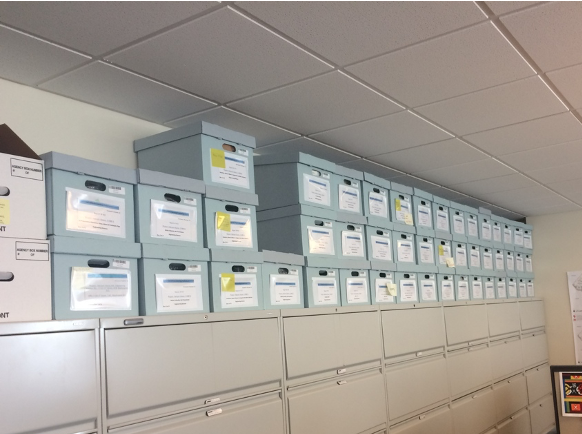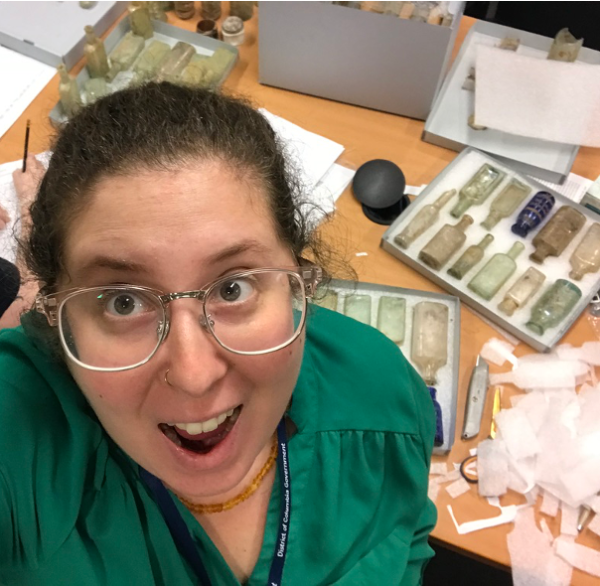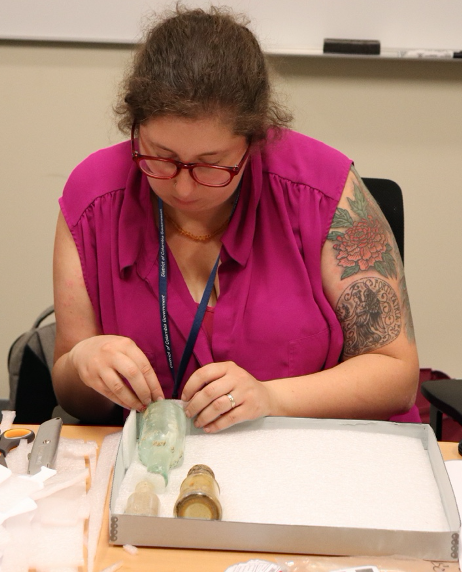Comments Sought for New Proposed Rule Concerning the Deaccession of Federally Owned and Administered Collections
By Giovanna Vitelli Chair, SHA Collections and Curation Committee The subject of deaccession, or the…

Well hello there, fellow archaeology grad student or other interested reader! In this three-part blog series, I will be providing practical advice for using archaeological collections for your PhD dissertation, MA Thesis, or other graduate student work. This is based on my personal experience, the experiences of colleagues, and collective advice I’ve gathered from mentors. In part 1, I’ll be introducing myself and my project, and giving an overview of how to create a project that uses archaeological collections. Part 2 of the series will focus on how to present and advocate for a collections-based project in a proposal or grant application. Part 3 will be about finding funding for your collections-based project.

Figure 1 Me, Jenn Lupu, excited for another day of research with collections! All photos personal.
My name is Jenn Lupu, I’m a PhD Candidate at Northwestern University, and I do historical archaeology. Before attending graduate school, I worked as a field and lab technician for various CRM (Cultural Resources Management) firms. I grew up in the Washington, DC area, and after college, I returned to the area for my first CRM job. Although I worked all over the mid-Atlantic, I was especially fascinated by cities and the history of urban experiences. I wrote an MA thesis on brothels in 1880s Washington, using archaeological reports and census data to analyze the spatial dynamics of brothels within the urban landscape (Lupu 2020). I knew I wanted to pursue work on Washington, DC for my PhD dissertation, but I was seeking a topic.
Luckily for me, I happened to be introduced to Dr. Ruth Trocolli, the District Archaeologist for Washington, DC. I met with her to talk about the possibility of doing a new excavation in Washington, and while she was open to it, she also showed me some previous collections, and highlighted one in particular. Halcyon House is a large mansion in the Georgetown neighborhood of DC. One of the earliest structures in the developing city, Halcyon House is a National Register Historic Landmark. In 1985, the owner of Halcyon agreed to hire an archaeological firm to excavate the site before he undertook an extensive construction project. The firm found many more artifacts than were expected, including a few Native American lithics, household trash deposits ranging from 1800-1930, and extensive glass bottle dumps. Funding disputes arose between the archaeologists and landowner, resulting in lawsuits. The project was never completed, and the artifacts and associated records were boxed and stored in the developer’s basement. In 2011, a volunteer for the District Archaeologist learned that the collection was about to be thrown away. Dr. Trocolli and the volunteer picked up the boxes, not knowing what was in the collection. They had time to quickly replace the boxes with archival ones but did not have time or sufficient labor power to fully inventory or catalogue the collection. What was known about the collection was a rumor – that in the early 20th century, a man named Albert Adsit Clemons was described in newspapers as “eccentric” and was said to have lived alone with a male carpenter. Newspaper articles from around the time of his death indicated that he was a strange character, who, with the help of the carpenter, built wild and strange additions to the house, including stairways that led nowhere, doors that opened onto walls, and a secret theater with a door designed to look like window shades. Was this a part of queer history? Could the artifacts or documents yield any insights into the relationship between Albert and the carpenter? Stay tuned for the answers to these questions and more….

Figure 2: rehousing bottles from the Halcyon Collection
The story of the Halcyon House collection may seem unusual, but in many ways it’s common. Archaeological repositories are bursting with collections that are unstudied or understudied. If you’re hooked and waiting to learn more about Halcyon’s mysteries, a collections-based project may be a great choice for you. For ethical, practical, and intellectual reasons, collections-based projects make great dissertations.
For decades, archaeologists and other scholars have called attention to what has been called the “collections crisis,” whereby an over-emphasis on funding excavation, with an under-emphasis on funding long-term collections storage has resulted in a burden of unstudied, understudied, and deteriorating archaeological collections (Childs and Warner 2019; MacFarland and Vokes 2016; Voss 2012). Further, many archaeologists have asserted that conducting collections-based research is essential for an ethical archaeological practice (i.e. Childs and Benden 2017; Lynott 2017; Scarre and Scarre 2006; Zimmerman et al 2003). As Voss points out, timing is crucial, because there is a risk of data loss and damage the longer collections remain unstudied (2012, 146). By taking on an understudied collection, graduate students can help to remedy this burden and assist repositories with managing their collections.
You might be tempted, at this point, but I bet you have one big concern left – Will a collections-based project allow me to get a job in archaeology? Will I be able to get dissertation funding? I have been told multiple times that excavating is an essential part of an archaeology dissertation and proves your skills in the field, which is necessary for getting jobs and grants. There’s definitely some truth to this. However, collections-based research has its own benefits. I ultimately chose a collections project in part because during my first year of grad school I had spine surgery and was worried my body would be unable to excavate later on. However, the choice has paid off many times over. As it turns out, if you pitch a collections-based project well, you can still get funding for your project (more on this in parts 2 and 3). In addition, collections work prepares graduate students for numerous academic-adjacent and alt-academia positions (that is, a job that uses academic qualifications or skills but is outside the university setting). These jobs can include positions at museums, CRM firms, historic sites, libraries, and repositories, which are often looking to hire archaeologists with collections experience. All of these positions in addition to traditional academic jobs. Many universities have archaeology museums or collections, and sometimes hire a collections specialist or seek out a professor who can simultaneously oversee the collections. Having collections experience helps to qualify you for these types of positions. In addition to the many collections positions outside academia, doing this research doesn’t disqualify you from academic jobs. Quite the opposite. Collections work can enable graduate students to start publishing earlier and develop valuable skills and expertise.
In these uncertain times, a collections-based project can allow graduate students to finish quickly and avoid delays due to unforeseen crises. When I was first applying to graduate school, a professor told me she recommended her students seek out collections projects, because they were more likely to be able to finish in 5 or 6 years. I was able to find and choose a dissertation collection during the summer after my first year of my PhD and continued working with it each summer until I moved to be close to the repository for my fieldwork year. For students with limited time in the field, collections can allow for a project where data collection mostly occurs over the summer. Or, some repositories will allow you to borrow materials to study at your home university’s lab. I had chosen the project in part because I wanted to ensure my health issues didn’t prevent me from finishing on time. When COVID-19 struck, I was again reminded of the resilience of collections research. I had already collected a decent amount of data and I had photographs and scanned paperwork I could access from home. I was able to work with the DC Historic Preservation Office to create a plan for a fully contactless approach to the remainder of my project.
While you may be advised that working with collections for your dissertation will limit your choices afterwards, I have found the opposite to be true. The field is coming around to seeing the value of collection research, and it enables new methodologies and research questions. In addition to being ethical, doing collections work will allow you to complete a dissertation on time, even in the face of unforeseen delays or obstacles. While certain jobs may turn away a collections researcher, having skills with collections opens up a plethora of other opportunities, both inside academia and in other sectors.

Figure 3 Boxes of Halcyon Collection artifacts, atop filing cabinets at the DC Historic Preservation office.
Ok, so by now you may be fully on board and excited, but perhaps you’re wondering how to go about it. Finding a collection to work with for your dissertation will probably be easier than you expect. You may find that repositories are eager to find researchers who want to catalogue their data. After all, in addition to providing you with a dissertation, your work with the collection will help the repository manage its materials, a mutually beneficial relationship.
With the help of the Archaeological Collections Consortium, the Collections and Curations Committee of the SHA has been working to create a database of archaeological repositories. This resource allows you to search by location to find repositories that house archaeological collections within the US. In some cases, the map provides contact information as well. This can be a good place to start searching and developing local contacts. You can access the 2017 version of the repository guide here. Stay tuned for an updated version that is in development now.
https://sha-gis.maps.arcgis.com/apps/MapJournal/index.html?appid=9025c4f06b594d089f8a6cb5d5676ac5
Contact Repositories, and/or Museums, State Historic Preservation Offices, and city Historic Preservation Offices in your area or your research site. If you are unsure of the repositories in the area check the repository link above. In talking to them, you can learn more about what they might have to offer. Another benefit of collections-based work is that you can seek out collections that relate to your research interests. While many collections and artifacts can yield valuable insights about the past, it can benefit graduate student to try to work with a collection where archaeological records are intact and provenience information can be gleaned. While it is possible to do amazing analysis with unprovenienced collections, having some ‘traditional’ archaeological methods discussion (such as interpreting stratigraphy etc.) can prove your knowledge in the science and practice of archaeology.
Beyond being ethical and practical, working with collections allows for new types of archaeological projects and exciting topics. Archaeologists have advocated for broad, synthetic projects that seek to draw together data beyond a single site (i.e. Kintigh et al 2014). Working with previously excavated collections enables synthetic work at a greater scale, through drawing together a range of previously excavated sites. In addition, collections-based research inspires new methodologies and approaches, such as inductive methodologies stemming from individual artifacts or groups of artifacts (Voss 2012, 157). Working with a previously excavated collection, especially one with some associated documentation, can allow a graduate student researcher to choose a dissertation topic that more closely fits with their theoretical and material specialties. For example, I chose to work with the Halcyon House collection because I knew at the outset that it had one of the largest collections of glass bottle artifacts found in DC (I enjoy and specialize in working with bottle glass), and it had definite ties to questions around sexuality and gender (theoretical research interests of mine). While an excavation project may be selected around these interests as well, it is more difficult to ensure you will find the specific types of data you are seeking for your project. By working with archaeological artifacts in new ways, collections-based research benefits the field of archaeology and allows for different types of research questions.
As I started going through and inventorying the boxes in the Halcyon House collection, the findings were beyond my expectations. Albert and the carpenter had lived during a time when there was regular trash collection, but they chose to bury several deposits of trash under a patio in the back yard. The items stylistically matched Albert’s taste in the post-death inventory of his house, with brightly colored lamp glass and imported East-Asian porcelains. But the trash deposit also included numerous fasteners for corsets, garters, stockings, and other items from lingerie marketed exclusively to women, along with traces of “theater makeup” and dozens of alcohol and food extract bottles. Collectively, together with the documents, these materials support the hypothesis that there was an underground drag scene at Halcyon during Prohibition. That’s not all! I’ve continued to uncover Halcyon’s colorful and strange history and have broadened my project to look at glass bottles from multiple collections to put Halcyon into the context of the city. I’ve done public education programs and found that people were very excited by the materials in the collection and how we can use them to learn about the past. By the end of my data collection, I will have much more than enough for a dissertation – the Halcyon materials and the city-scale combined are providing me with nearly a career’s worth of data to analyze. Even with the unexpected setbacks of the COVID pandemic, I will still be able to collect enough data for my dissertation, keeping to my originally proposed timeline. Plus, as you will hear in parts two and three, I have been able to obtain research funding to support my project. While I was warned choosing a collection might be a risk, in the end it has paid off many times over.
Childs, S. Terry, and Danielle M. Benden. 2017. “A Checklist for Sustainable Management of Archaeological Collections.” Advances in Archaeological Practice 5 (1): 12–25.
Childs, S. Terry, and Mark S. Warner. 2019. Using and Curating Archaeological Collections. SAA: Washington, DC.
Kintigh, K.W., J.H. Altschul, M.C. Beaudry, R.D. Drennan, A.P. Kinzig, T.A. Kohler, W.F. Limp, H.D. G. Maschner, W.K. Michener, T.R. Pauketat, P. Peregrine, J.A. Sabloff, T.J. Wilkinson, H.T. Wright, and M.A. Zeder. 2014. Grand Challenges for Archaeology. American Antiquity, 79(1): 5-24.
Lupu, Jennifer A. 2020. “Landscapes of Power and De- sire: A Geographical Analysis of Washington, D.C.’s Nineteenth-Century Brothel District.” In Historical Sex Work: New Contributions from History and Archaeol- ogy, edited by Kristen Fellows, Angela Smith, and Anna Munns, 27–50. Gainesville, FL: University Press of Florida.
Lynott, Mark J. 1997. “Ethical Principles and Archaeological Practice: Development of an Ethics Policy.” American Antiquity 62 (4): 589–99. https://doi.org/10.2307/281879.
MacFarland, Kathryn, and Arthur W. Vokes. 2016. “Dusting Off the Data: Curating and Rehabilitating Archaeological Legacy and Orphaned Collections.” Advances in Archaeological Practice, 4 (2): 161–75
Scarre, Chris, and Geoffrey Scarre. 2006. The Ethics of Archaeology: Philosophical Perspectives on Archaeological Practice. Cambridge University Press.
Voss, Barbara L. 2012. “Curation as Research. A Case Study in Orphaned and Underreported Archaeological Collections.” Archaeological Dialogues, 19 (2): 145–69.
Zimmerman, Larry J., Karen D. Vitelli, and Julia J. Hollowell, editors. 2003. Ethical Issues in Archaeology. Rowman Altamira.